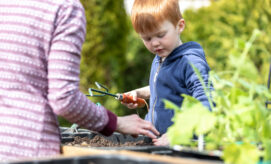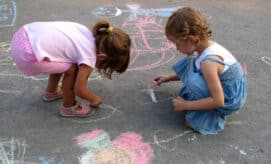Early learning centers are re-opening after closures from COVID-19 with the goal of keeping children as safe and healthy as possible. This means making big changes to classrooms, curriculum, and the activities that children will be engaging in while they are at school. Effective safety practices include social distancing, avoiding shared materials, and moving as many activities as possible to outside spaces.
In this article we list activities for even the youngest children in your care that encourage engaged, creative play while safely social distancing:
Infants
No toys? No problem! With the littlest learners, getting outside to explore the sights, sounds, and texture in nature is a fun experience in itself! Bring infants outside without shoes to feel the sand and grass between their fingers and toes. If you have a blanket available, set it up under a shady tree where the infant can practice tummy time while looking around at all of the interesting sights. Or, help the infant lie on his or her back to look up at the leaves in the trees. Because it’s warm outside, you’ll need to be careful of the baby’s skin. Make sure you have sunscreen or a wide-brimmed, protective hat. Click here to find more information about how to get the most out of outdoor play with infants.











